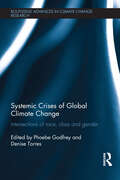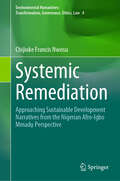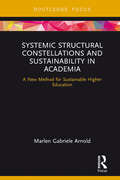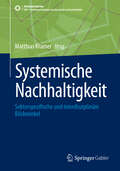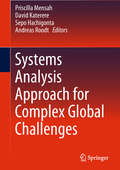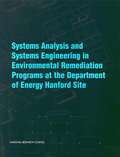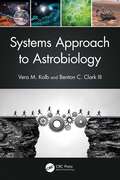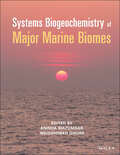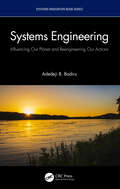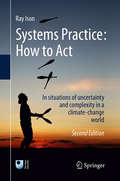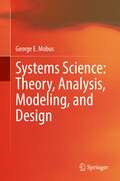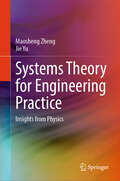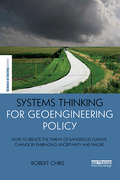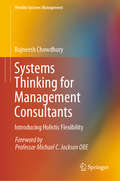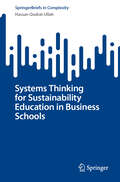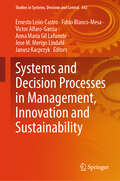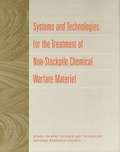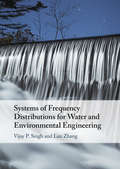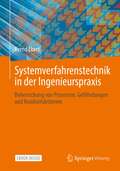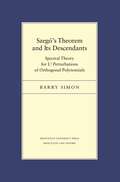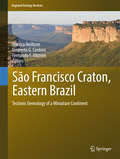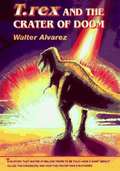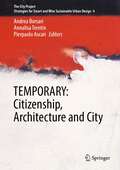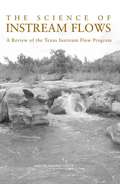- Table View
- List View
Systemic Crises of Global Climate Change: Intersections of race, class and gender (Routledge Advances in Climate Change Research)
by Phoebe Godfrey Denise TorresSociological literature tends to view the social categories of race, class and gender as distinct and has avoided discussing how multiple intersections inform and contribute to experiences of injustice and inequity. This limited focus is clearly inadequate. Systemic Crises of Global Climate Change is an edited volume of 49 international, interdisciplinary contributions addressing global climate change (GCC) by intentionally engaging with the issues of race, gender, and class through an intersectional lens. The volume challenges and inspires readers to foster new theoretical and practical linkages and think beyond the traditional, and oftentimes reductionist, environmental science frame by examining issues within their turbulent political, cultural, and personal landscapes. Varied media and writing styles invite students and educators to reflexively engage different, yet complementary, approaches to GCC analysis and interpretation, mirroring the disparate voices and viewpoints within the field. The second volume, Emergent Possibilities for Sustainability will take a similar approach but will examine the possibilities for solutions, as in the quest for global sustainability. This book is a valuable resource for academics, researchers and both undergraduate and post-graduate students in the areas of Environmental Studies, Climate Change, Gender Studies and International studies as well as those seeking a more intersectional analysis of GCC.
Systemic Remediation: Approaching Sustainable Development Narratives from the Nigerian Afro-Igbo Mmadụ Perspective (Environmental Humanities: Transformation, Governance, Ethics, Law #4)
by Chijioke Francis NwosuSince the issues and discourses surrounding sustainable development entered its phase in our contemporary world, the political, social, economic, ecological, and cultural existence of our modern world has inevitably adopted varied measures to respond better to the demands of our time. This book contributes to the global call for transitions and transformations towards a more sustainable human society. This contribution is specific, dialogic and comparative and also has deep cultural and ethnological consciousness based on the Nigerian experiences and, by extension, the African experience. The research work presents as its background the hypothesis that varied forms of structures—socio-political, socio-economic, socio-ecological and socio-cultural—unite to constitute ‘structural sins’ (John Paul II) and, consequently, the banes to authentic and sustainable development. These dysfunctional structures were critically analysed and evaluated. Furthermore, the research work takes up the contemporary discourse on sustainable development, beginning with earlier development concepts, the impactful contribution of social documents of the church to development discourse, the timeline of the general global and sustainable development approach and governance, as well as the specifics of the twin documents of the year 2015, namely Agenda 2030 and Laudato Si. Again, an indigenised manuscript for development discourse known as Nigeria Vision 20:2020 was examined to delineate the fact that forms of indigenous efforts to discuss and administrate the development process are noticeable. However, such efforts have remained negatively exploited by both internal and external man-made corrupt factors. One such factors discussed in this book, among others, is the failure of Nigeria since independence to stabilise its power and energy sector.
Systemic Structural Constellations and Sustainability in Academia: A New Method for Sustainable Higher Education
by Marlen ArnoldIn order to create truly sustainable universities, we require new methods of visualising and interpreting them holistically as institutions built on complex relationships and systems, rather than as individual departments and people operating independently. This book uses a systemic structural constellations approach to demonstrate how we can build more sustainable higher education institutions, both in terms of teaching and research and at an operational level. Drawing examples from current research and teaching, Systemic Structural Constellations and Sustainability in Academia explores how universities are not only centres of teaching and learning but can also play a crucial role in enabling future decision-makers to appreciate and contribute to a more sustainable future. Providing a clear introduction to systemic structural constellations and guidance on how to practically apply the theory to numerous aspects of the higher education system, this book will be of great interest to students and researchers of education for sustainable development, organisational learning and sustainable management, as well as those tasked with transforming the higher education system for the future.
Systemische Nachhaltigkeit: Sektorspezifische und interdisziplinäre Blickwinkel (SDG - Forschung, Konzepte, Lösungsansätze zur Nachhaltigkeit)
by Matthias KramerDie Auswirkungen des Klimawandels sind längst mehr als nur ein gefühltes Phänomen. Sie zeigen sich weltweit mit zunehmender regionaler Intensität. Deutschland ist aktuell besonders von Starkregenereignissen mit Überschwemmungskatastrophen und Dürreperioden mit massiven Waldschäden betroffen. Die notwendige Reduzierung klimarelevanter Emissionen artikuliert sich u. a. in Maßnahmen zur Verkehrswende, Bau- und Infrastrukturwirtschaft, Landwirtschaft und zum Konsumentenverhalten. Zielkonflikte, wie beim Übergang vom fossilen Zeitalter zu Erneuerbaren Energien und von weniger Globalisierung zu mehr Regionalisierung, gilt es durch eine simultane Planung von Klima-, Umwelt- und Naturschutz wirtschaftswissenschaftlich orientiert zu managen. Dieser Anspruch und die Fokussierung auf mehrere SDGs im Rahmen der nachhaltigen Entwicklung stellen die fachlichen Schnittstellen zwischen den Buchbeiträgen dar. Das Buch richtet sich an Studierende, Wissenschaftler, politische Entscheidungsträger und Praktiker, die sich mit Nachhaltigkeitsthemen sowie den interdisziplinären Auswirkungen des Klimawandels befassen.
Systems Analysis Approach for Complex Global Challenges
by Priscilla Mensah David Katerere Sepo Hachigonta Andreas RoodtThis book, which contains a collection of review articles as well as focus on evidence-based policy making, will serve as a valuable resource not just for all postgraduate students conducting research using systems analysis thinking but also for policy makers. To our knowledge, a book of this nature which also has a strong African focus is currently not available. The book examines environmental and socio-economic risks with the aim of providing an analytical foundation for the management and governance of natural resources, disasters, addressing climate change, and easing the technological and ecological transitions to sustainability. It provides scientific and strategic analysis to better understand the dynamics of future energy transitions, their main driving forces, enabling factors, barriers, as well as their consequences for the social, economic and environmental dimensions of human wellbeing. Science-based policy advice is achieved through an integrated assessment and modeling of how to simultaneously address the major energy policy challenges in the areas of environment (climate change and air pollution), energy poverty (or access to affordable and clean energy for the poor), energy security and reliability. It also aims to improve our understanding of ecosystems and their management in today’s changing world—in particular, the current state of ecosystems, and their ecological thresholds and buffering capacities. It provides support for policy makers in developing rational, realistic and science-based regional, national and global strategies for the production of fuel, food and fibre that sustain ecosystem services and safeguard food security. Finally, it addresses the human development dimension of global change based on comprehensive studies on the changing size and composition of human populations around the world by analyzing both their impacts and the differential vulnerabilities by age, gender and level of education.
Systems Analysis and Systems Engineering in Environmental Remediation Programs at the Department of Energy Hanford Site
by Tank Wastes Committee on Remediation of BuriedInformation on Systems Analysis and Systems Engineering in Environmental Remediation Programs at the Department of Energy Hanford Site
Systems Approach to Astrobiology
by Vera M. Kolb Benton C. ClarkSystems thinking/analysis is widely applied for solving complex problems in engineering and certain other fields. Astrobiology, which inherently involves complex problems, can benefit from such an approach.
Systems Biogeochemistry of Major Marine Biomes
by Aninda Mazumdar Wriddhiman GhoshSystems Biogeochemistry of Major Marine Biomes A comprehensive system-level discussion of the geomicrobiology of the Earth’s oceans In Systems Biogeochemistry of Major Marine Biomes, a team of distinguished researchers delivers a systemic overview of biogeochemistry across a number of major physiographies of the global ocean: the waters and sediments overlying continental margins; the deep sub-surfaces; the Arctic and Antarctic oceans; and the physicochemical extremes such as the hypersaline and sulfidic marine zones, cold methane seeps and hydrothermal ecosystems. The book explores state-of-the-art advances in marine geomicrobiology and investigates the drivers of biogeochemical processes. It highlights the imperatives of the unique, fringe, and cryptic processes while studying the geological manifestations and ecological feedbacks of in situ microbial metabolisms. Taking a holistic approach toward the understanding of marine biogeochemical provinces, this book emphasizes the centrality of culture-dependent and culture-independent (meta-omics-based) microbiological information within a systems biogeochemistry framework. Perfect for researchers and scientists in the fields of geochemistry, geophysics, geomicrobiology, oceanography, and marine science, Systems Biogeochemistry of Major Marine Biomes will also earn a place in the libraries of policymakers and advanced graduate students seeking a one-stop reference on marine biogeochemistry.
Systems Engineering: Influencing Our Planet and Reengineering Our Actions (Systems Innovation Book Series)
by Adedeji B. BadiruPeople want to create a better world and planet; however, where, and how to start remains the question. Systems Engineering’s problem-solving methodology can help with its ability to answer multiple questions along with connecting actions and impacts. This book uses the Systems Engineering problem-solving methodology to frame how each answer impacts the planet when multiple actions are strung together no matter where they take place. Systems Engineering: Influencing Our Planet and Reengineering Our Actions illustrates a hierarchical Systems Engineering view of the world with each individual in mind as a link in the chain. It uses an Industrial Engineering framework for action implementations and identifies humans’ interconnected actions. The book discusses the implementation of the Systems Engineering problem-solving methodology and leverages existing concepts of environmental sustainability. A template is present for personal actions for environment social responsibility using a Systems Engineering problem-solving approach and focuses on the foundational use of the trademarked DEJI Systems Model® for action design, evaluation, justification, and integration. This book is a perfect read for all academic disciplines and all engineering fields, as well as business and management fields. It reminds us of the Environmental Foundation of NAE’s 14 Grand Challenges and the part we can play.
Systems Practice: How to Act
by Ray IsonIt is now accepted that humans are changing the climate of the Earth and this is the most compelling amongst a long litany of reasons as to why, collectively, we have to change our ways of thinking and acting. Most people now recognise that we have to be capable of adapting quickly as new and uncertain circumstances emerge: this capability will need to exist at personal, group, community, regional, national and international levels, all at the same time. Systems Practice is structured into four parts. Part I introduces the societal need to move towards a more systemic and adaptive governance against the backdrop of human-induced climate change. Part II unpacks what is involved in systems practice by means of a juggler metaphor; examining situations where systems thinking offers useful understanding and opportunities for change. Part III identifies the main factors that constrain the uptake of systems practice and makes the case for innovation in practice by means of systemic inquiry, systemic action research and systemic intervention. The book concludes with Part IV, which critically examines how systems practice is, or might be, utilised at different levels from the personal to the societal. The development of our capabilities to think and act systemically is an urgent priority and Systems Practice aims to show how to do systems thinking and translate that thinking into praxis (theory informed practical action) which will be welcomed by those managing in situations of complexity and uncertainty across all domains of professional and personal concern.
Systems Science: Theory, Analysis, Modeling, and Design
by George E. MobusThis book describes a comprehensive approach to applying systems science formally to the deep analysis of a wide variety of complex systems. Detailed ‘how-to’ examples of the three phases (analysis-modeling-design) of systems science are applied to systems of various types (machines, organic (e.g. ecosystem), and supra-organic (e.g. business organizations and government). The complexity of the global system has reached proportions that seriously challenge our abilities to understand the consequences of our use of technology, modification of natural ecosystems, or even how to govern ourselves. For this reason, complex mathematics is eschewed when simpler structures will suffice, allowing the widest possible audience to apply and benefit from the available tools and concepts of systems science in their own work. The book shows, in detail, how to functionally and structurally deconstruct complex systems using a fundamental language of systems. It shows how to capture the discovered details in a structured knowledge base from which abstract models can be derived for simulation. The knowledge base is also shown to be a basis for generating system design specifications for human-built artifacts, or policy recommendations/policy mechanisms for socio-economic-ecological systems management. The book builds on principles and methods found in the authors’ textbook Principles of Systems Science (co-authored with Michael Kalton), but without prerequisites. It will appeal to a broad audience that deals with complex systems every day, from design engineers to economic and ecological systems managers and policymakers.
Systems Theory for Engineering Practice: Insights from Physics
by Jie Yu Maosheng ZhengThis book presents cognition of the universality of systems theory thinking by using some ordinary physical phenomena and their methods in study, of which the involved treatments are consistent with the viewpoint of systems theory. It contains the collective actions of classical vibration of many bodies and wave, the extreme value problem in natural world, status of electrons in atom-molecule and metals, Ising model in phase transition and elementary excitation in solid, multi-objective optimization in a system, description of effective media approximation, certainty in uncertain phenomena, all these reflect the cooperative/synergetic effects, wholeness of group actions, “unity of opposites” inside a system, and collective phenomena in a system completely. The relevant methodologies for systems theory are organic combination and synergism of both “reductionism” and “holism” instead of “confrontation” or “separation” of them, which could be used in dealing with analogous problems in systems science and engineering fields in response to the idiom of “stones from other hills being good for polishing this jade” and “comprehend by analogy”, so as to promote the transformation of wisdom to productivity. The authors wish this work could play its role as a paving stone to serve the research and application of systems theory. This book can be used as a textbook for postgraduate and advanced undergraduate students in relevant majors, and a reference book for scientists and practitioners in related fields.
Systems Thinking for Geoengineering Policy: How to reduce the threat of dangerous climate change by embracing uncertainty and failure (The Earthscan Science in Society Series)
by Robert ChrisEven by the scientists most closely associated with it, geoengineering - the deliberate intervention in the climate at global scale to mitigate the effects of climate change - is perceived to be risky. For all its potential benefits, there are robust differences of opinion over the wisdom of such an intervention. Systems Thinking for Geoengineering Policy is the first book to theorise geoengineering in terms of complex adaptive systems theory and to argue for the theoretical imperative of adaptive management as the default methodology for an effective low risk means of confronting the inescapable uncertainty and surprise that characterise potential climate futures. The book illustrates how a shift from the conventional Enlightenment paradigm of linear reductionist thinking, in favour of systems thinking, would promote policies that are robust against the widest range of plausible futures rather than optimal only for the most likely, and also unlock the policy paralysis caused by making long term predictions of policy outcomes a prior condition for policy formulation. It also offers some systems driven reflections on a global governance network for geoengineering. This book is a valuable resource for all those with an interest in climate change policy, geoengineering, and CAS theory, including academics, under- and postgraduate students and policymakers.
Systems Thinking for Management Consultants: Introducing Holistic Flexibility (Flexible Systems Management)
by Rajneesh ChowdhuryThis book discusses how systems thinking and approaches can aid management consultants in navigating the complexities of client advisory in current realities. It thereby brings to the forefront aspects of holism, flexibility and responsibility - the keys to success in today’s world. Management consultants are called in to offer an independent expert view of an organisation/ a situation and are expected to address some of the most pressing problems businesses face. The client does not exist in a silo, but in a complex environment that lies at the intersection of a range of internal and external factors that are often unseen and unpredictable. The organisation itself presents an alien territory that the consultant is expected to acclimatise to within a very short period of time, and come up with solutions that “insiders” would not have been able to visualise. The book presents a range of ideas, concepts and reference cases that are relevant and topical for consultants in their daily work. It argues that systems thinking allows holism and flexibility in management consulting – while holism is about the ability to encompass the environmental and organisational complexity, flexibility is about the ability to think creatively and adopt different approaches to accommodate this complexity. With commentaries, case studies, conceptual models and perspectives that cut across multiple industries, sectors and countries, this book is a valuable resource for academics and professionals alike. The book’s inner pages and its page on Springer.com contain additional comments providing perspectives of clients, industry experts and academia.
Systems Thinking for Sustainability Education in Business Schools (SpringerBriefs in Complexity)
by Hassan Qudrat-UllahThis book delves into the current state and future prospects of systems thinking and sustainability education within business schools. It meticulously examines the trends and drivers shaping the demand and supply of such education, along with the implications and challenges it presents for various stakeholders and society at large. Strategic recommendations and suggestions are provided to elevate and propel systems thinking and sustainability education in business schools, outlining a visionary roadmap for the future. Furthermore, the book explores the intersectionality of sustainability and diversity in business education, offering examples and cases of visionary and innovative initiatives and projects in the field. Distinguished by special features such as illustrations, the book offers a comprehensive and integrative overview of the current landscape and future trajectories of systems thinking and sustainability education in business schools. The primary benefit for readers lies in gaining a deeper and broader understanding of systems thinking and sustainability education in business schools. It equips them with the knowledge to apply systems thinking and sustainability principles and tools to tackle the complex and wicked problems of the twenty-first century. Additionally, the book aims to inspire and inform business schools and their stakeholders to embrace and enhance systems thinking and sustainability education in their curricula and pedagogy, contributing to the advancement of sustainability and systems thinking in both business and society.
Systems and Decision Processes in Management, Innovation and Sustainability (Studies in Systems, Decision and Control #562)
by Janusz Kacprzyk Ernesto León-Castro Fabio Blanco-Mesa Victor Alfaro-Garcia Anna Maria Gil Lafuente Jose M. Merigo LindahlThe book presents a series of papers with different methodologies that allow us to visualize how the systems support decision-making in areas such as the tourism sector, entrepreneurship, quality of work life, gender, motivation, circular economy, innovation, law, finance, and bibliometrics. The book also finds a series of cases applied in different countries, where through the information collected and the data analyzed, new improvement processes can be generated at the business level and the local, regional, and national levels within Ibero-America. The book presents new methods and systems to create better decision-making processes in the changing and uncertain environments in which people, companies, and governments interact.
Systems and Technologies for the Treatment of Non-Stockpile Chemical Warfare Materiel
by National Research CouncilThe main approach adopted by the U. S. Army for destruction of all declared chemical weapon materiel (CWM) is incineration. There has been considerable public opposition to this approach, however, and the Army is developing a mix of fixed site and mobile treatment technologies to dispose of non-stockpile CWM. To assist in this effort, the Army requested NRC to review and evaluate these technologies, and to assess its plans for obtaining regulatory approval for and to involve the public in decisions about the application of those technologies. This book presents an assessment of non-stockpile treatment options and the application of these systems to the non-stockpile inventory, of regulatory and permitting issues, and of the role of the public.
Systems of Frequency Distributions for Water and Environmental Engineering
by Vijay P. Singh Lan ZhangA multitude of processes in hydrology and environmental engineering are either random or entail random components which are characterized by random variables. These variables are described by frequency distributions. This book provides an overview of different systems of frequency distributions, their properties, and applications to the fields of water resources and environmental engineering. A variety of systems are covered, including the Pearson system, Burr system, and systems commonly applied in economics, such as the D'Addario, Dagum, Stoppa, and Esteban systems. The latter chapters focus on the Singh system and the frequency distributions deduced from Bessel functions, maximum entropy theory, and the transformations of random variables. The final chapter introduces the genetic theory of frequency distributions. Using real-world data, this book provides a valuable reference for researchers, graduate students, and professionals interested in frequency analysis.
Systemverfahrenstechnik in der Ingenieurspraxis: Beherrschung von Prozessen, Gefährdungen und Reinheitskriterien
by Bernd EbertDas Buch behandelt die für das Optimum verfahrenstechnischer Prozesse unerlässliche System-Betrachtung. Diese sollte nicht nur für den „reinen“ Prozess erfolgen, sondern für den gesamten Lebenszyklus technischer Anlagen – vom Entwurf eines Prozesses bis zur Optimierung im laufenden Betrieb. Dabei kommt es nicht nur auf den Normalbetrieb an (wie häufig bei Simulationen betrachtet), sondern auch auf An- und Abfahrprozesse, das Havarie-/Störungsverhalten der Prozesse, die Reinigungsabläufe, Sicherheitsmaßnahmen usw. Geeignete Analyse- und Betrachtungsmethoden werden dazu vorgestellt, die sich in langjähriger Planungs- und Betriebspraxis herausgebildet haben. Hierzu zählen u.a. Risikoanalysen, Zeitdynamik- und Zuverlässigkeitsmethoden; deren theoretischer Ansatz wird mit ihrer praktischen Anwendbarkeit verbunden. Auch Aspekte wie Industrie 4.0 und Prozessänderungen bei laufenden Anlagen werden betrachtet. Damit soll ein Beitrag sowohl für die Ingenieurausbildung, die technische Betriebsbetreuung als auch für die Projektabwicklung geleistet werden.
Szegő's Theorem and Its Descendants: Spectral Theory for L2 Perturbations of Orthogonal Polynomials (Porter Lectures #6)
by Barry SimonThis book presents a comprehensive overview of the sum rule approach to spectral analysis of orthogonal polynomials, which derives from Gábor Szego's classic 1915 theorem and its 1920 extension. Barry Simon emphasizes necessary and sufficient conditions, and provides mathematical background that until now has been available only in journals. Topics include background from the theory of meromorphic functions on hyperelliptic surfaces and the study of covering maps of the Riemann sphere with a finite number of slits removed. This allows for the first book-length treatment of orthogonal polynomials for measures supported on a finite number of intervals on the real line. In addition to the Szego and Killip-Simon theorems for orthogonal polynomials on the unit circle (OPUC) and orthogonal polynomials on the real line (OPRL), Simon covers Toda lattices, the moment problem, and Jacobi operators on the Bethe lattice. Recent work on applications of universality of the CD kernel to obtain detailed asymptotics on the fine structure of the zeros is also included. The book places special emphasis on OPRL, which makes it the essential companion volume to the author's earlier books on OPUC.
São Francisco Craton, Eastern Brazil
by Monica Heilbron Umberto G. Cordani Fernando F. AlkmimThe region of the São Francisco river valley in eastern Brazil encompasses two main components of the geologic framework of the South American continent: the São Francisco craton and its marginal orogenic belts. Cratons, as the oldest, differentiated and relatively stable pieces of the continental lithosphere, preserve a substantial part of the Earth's memory. Orogenic belts, on the other hand, record collisional processes that occurred during a limited time span. Because of their topographic relief, mountain belts developed along craton margins provide however access to rock successions not exposed in the low lands of the adjacent cratons. The combination of geologic information obtained in cratonic domains and their marginal orogenic belts thus form the basis for deciphering substantial periods of Earth's history. Corresponding to the most intensively studied portion of the Precambrian nucleus of the South American plate, the São Francisco craton and its margins host a rock record that spans from the Paleoarchean to the Cenozoic. Precambrian sedimentary successions that witness ancient Earth processes - many of them of global significance - are especially well preserved and exposed in this region. With all these attributes the São Francisco craton together with its fringing orogenic belts can be viewed as a 'Continent within a Continent' or a 'Continent en miniature'.
T. Rex and the Crater of Doom
by Walter AlvarezA geologist describes his research into the extinction of Tyrannosaurus rex and all dinosaurs, caused by a comet or asteroid hitting the Earth.
TBM Design and Construction
by Kui Chen Shengjun Jiao Jiangka WangThis book comprehensively covers the latest technology of TBM's structure and working principle, selection and adaptability design, cutter head design, construction organization and risk control and discusses typical domestic and global case studies on different periods of major TBM projects. Through detailed data and accurate charts, it offers operational guidance with high empirical value. This book is suitable for design, manufacturing, project management, construction and civil and mechanical engineering in the field of TBM technology.
TEMPORARY: Citizenship, Architecture and City (The City Project #4)
by Andrea Borsari Annalisa Trentin Pierpaolo AscariThis book offers a comprehensive overview of forces shaping urban renewal and the sustainable and inclusive transformation of contemporary cities. It discusses temporariness and uncertainty of citizenship, participation, and inclusion, as well as the energy and digital transformation, merging different perspectives, such as the social, philosophical, economic, and architectural ones. Based on revised and extended contributions to the International Congress “TEMPORARY: Citizenship, Architecture and City", held virtually on November 20-21, 2022, from the University of Bologna, this book offers extensive information and a thought-provoking reading to researchers in architecture, anthropology, social and environmental policy, as well as to professionals and policy makers involved in planning the city of the future.
THE SCIENCE OF INSTREAM FLOWS: A Review of the Texas Instream Flow Program
by National Research Council of the National AcademiesAcross the United States, municipalities, counties, and states grapple with issues of ensuring adequate amounts of water in times of high demand and low supply. Instream flow programs aim to balance ecosystem requirements and human uses of water, and try to determine how much water should be in rivers. With its range of river and ecosystem conditions, growing population, and high demands on water, Texas is representative of instream flow challenges across the United States, and its instream flow program may be a model for other jurisdictions. Three state agencies—the Texas Water Development Board (TWDB), the Texas Parks and Wildlife Department (TPWD), and the Texas Commission on Environmental Quality (TCEQ)—asked a committee of the National Research Council (NRC) to review the Programmatic Work Plan (PWP) and Technical Overview Document (TOD) that outline the state’s instream flow initiative. The committee suggested several changes to the proposed plan, such as establishing clearer goals, modifying the flow chart that outlines the necessary steps for conducting an instream flow study, and provide better linkages between individual studies of biology, hydrology and hydraulics, physical processes, and water quality.
